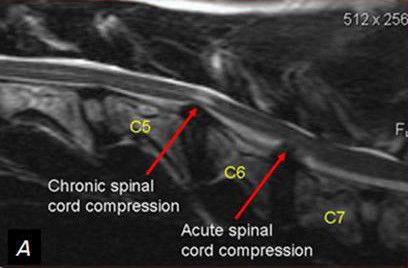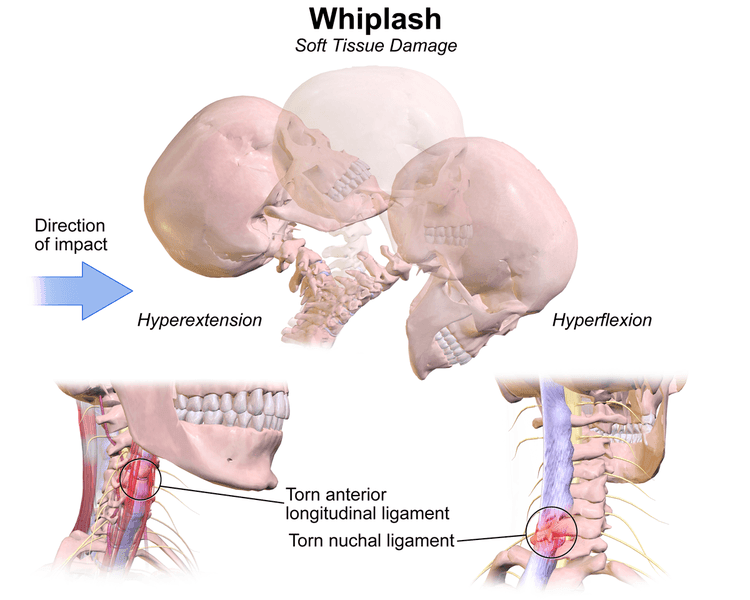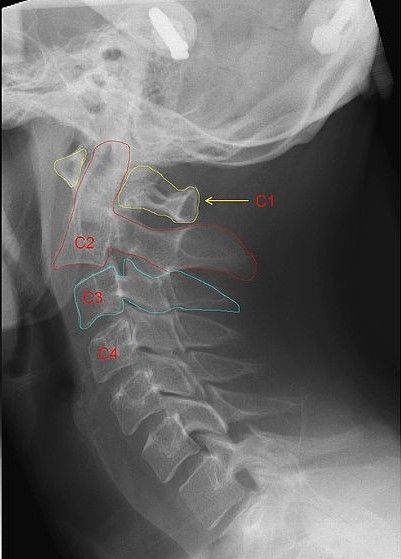Next Lesson - Conditions of the Shoulder and Clavicle
Core
Want more information on anatomy before you begin looking at conditions? Head to our article on The Spine for more information!
Thoracic cord compression is commonly caused by vertebral fractures and tumours. It presents with pain in the thoracic spine, spastic paralysis of the lower limb muscles, paraesthesia of dermatomes distal to the site of compression and loss of sphincter control. If the compression is around T5, there may also be reduced chest expansion on inspiration.
Diagnostic tests may involve spinal X-ray, CT or MRI scans. Treatment can include NSAIDS, steroidal injection, physical therapy and/or surgery to relieve pressure on the spinal cord.
Cervical myelopathy is the narrowing of the cervical spinal canal causing spinal cord compression. Causes include spondylosis, spondylolisthesis, congenital stenosis of the spinal canal, trauma or a tumour. It classically presents with a loss of balance, poor coordination, decreased dexterity and limb weakness/numbness. It can cause L’Hermitte’s phenomenon – intermittent ‘electrical shocks’ in the limbs exacerbated by neck flexion.
Cervical myelopathy is diagnosed with a thorough neurological examination and an MRI scan. As spondylosis/spondylolisthesis are the most common causes, treatment is usually surgical intervention. A conservative approach may have some short term symptom relief, but as the condition is degenerative, progressive neurological deterioration will continue.

Diagram - An MRI scan of cervical myelopathy
Creative commons source by Filippo Adamo [CC BY-SA 4.0 (https://creativecommons.org/licenses/by-sa/4.0)]
Whiplash is a forceful hyper-extension, hyper-flexion injury of the cervical spine with associated ligament damage. It is commonly caused by a rapid deceleration for example in a car crash. It presents with neck pain and can cause spinal cord injury, shoulder pain and lower back pain additionally. Whiplash usually self-resolves but it is advised to keep the neck mobile, continue with normal activities and to take over the counter painkillers.

Diagram - The pathophysiology behind whiplash injury
Creative commons source by BruceBlaus [CC BY-SA 4.0 (https://creativecommons.org/licenses/by-sa/4.0)]
A ‘Hangman’s fracture’ is a fracture through the pars interarticulares of the axis (C2 vertebra). It is usually caused by forcible hyperextension of the neck, classically caused through hanging. It is very unlikely to damage the spinal cord because the fracture itself expands the spinal canal, so it typically presents with neck pain alone.
Diagnosis is confirmed with an X-ray or sometimes a CT scan. Treatment can range from a neck brace to neck immobilisation (a form of skeletal traction) to surgical intervention.

Diagram - An X-ray of a Hangman's fracture with the first 4 cervical vertebrae highlighted
Creative commons source by Lucien Monfils, edited by Thomas Burnell [CC BY-SA 4.0 (https://creativecommons.org/licenses/by-sa/4.0)]
A ‘Jefferson’s fracture’ is a fracture of the atlas (C1 vertebra) caused by axial loading e.g. diving into a shallow pool. It presents with upper neck pain but no neurological symptoms. Diagnosis is confirmed with an X-ray or sometimes a CT scan. Treatment can range from a neck brace to neck immobilisation (a form of skeletal traction) to surgical intervention (especially if the transverse ligament is damaged).
Reviewed by: Dr. Thomas Burnell
Edited by: Dr. Maddie Swannack
- 5633

